Difficult to lose, easy to lose and impossible to protect. Wait a minute though ...
Hi, Giktayms! Mining in a short time made more noise than the confrontation of the state and instant messengers, neural network musicians and encryption viruses combined. The miners-miners became sharply more, the computer hardware jumped in price, and the cryptocurrency indices twitched nervously and made the miners themselves twitch-twitch. Today we will try to answer the question “who are all these people?”, To find out why cryptocurrencies have become a significant force, how they are mined, and understand how virtual money protects against theft after long months of mining.
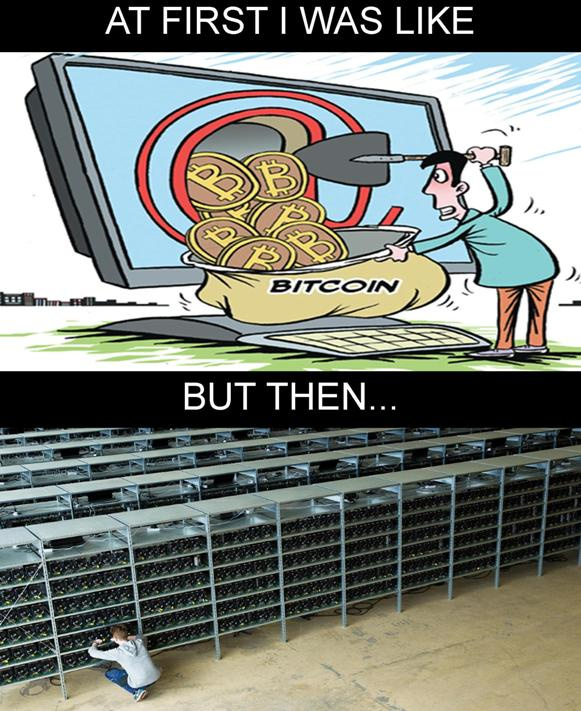
They began to talk about “digital gold” 9 years ago - then with caution, not with enthusiasm, like today. Even in Russia, with its relatively inexpensive electric power, few people believed that distributed solving arithmetic problems with subsequent remuneration for, then, “pennies” would become truly profitable. Around the first popular currency of this type, Bitcoin , was puzzled by financial analysts, geeks, entrepreneurs, and traders of prohibited goods. A large number of enthusiasts are still perplexed how “financial pyramids”, which they consider cryptocurrency, can interest someone. Therefore, for those who, for some reason, did not immerse themselves deeply in the subject, we will try to “explain on fingers” the history of the issue.
Since 2008, Bitcoin has remained “elusive Joe” for several years in a row, but banks inconsistently liked transactions independent of banks, and with the advent of exchanges, it finally became possible to “feel” cryptocurrency after cashing. At the same time, the rate showed a steady growth, and organizations and individuals who accepted payment by coin became more day by day. In general, it was not only pizza that could be bought on Bitcoin. And when the currency became popular, and its course set new records, Bitcoin again became a highly specialized topic, “mere mortals” lost all interest in it. Why did it happen?
Bitcoin, as the first cryptocurrency, "shot" not spontaneously, but when the stars came together in the right way:
• Blockchain - all head! Distributed database of all transactions inanonymous pseudo- anonymous cryptocurrency. Imagine a handyman Vasya, who dug from here to dawn for piecework. From the point of view of the legislation, Vasily is not protected in any way, because there was no labor contract (in terms of cryptocurrency - a banking operation) between the employee and the employer. But bitcoin is designed so that the chronicle “Vasya was offered to dig for 1000 rubles so many meters” with subsequent entries “Vasya dug up” remains flammable and is stored immediately by all employers and employees.

The short answer to the question “what did you all find in this bitcoin?”
Vasya’s report “this scoundrel did not pay for work” also spreads throughout the network, so it’s pointless to fake transactions or “cheat” with the results of cryptocurrency mining (solving a mathematical problem with hardware and opening a new Bitcoin block) , and such an operation simply will not be valid.
• There were no legal obstacles to cryptocurrency . They are now outlined, but Bitcoin and the company will not be classified as monetary substitutes, government regulators will not (because this definition is incorrect), and measures to regulate currencies are also very vague.
• Protection against a sudden emission or “we, the US government, have printed more dollars, and then the old ones end.” No one can add to the maximum number of bitcoins (21 million) a little bit more.

Miners around!
True, there are also "pitfalls" - high volatility (fluctuations in the rates of cryptocurrency) and the complexity of mining. The more blocks of cryptocurrency miners opened, the more difficult it was to extract it in the future. In the good old days, Bitcoin could simply be minted on a central processor of a home PC, then it became more profitable to perform mathematical tasks of the same type on a GPU using shader units (ALU - arithmetic and logic unit), and this was a new round of mining.
A peak in the popularity of video card mining came at the release of the Radeon 7000 series and the “six hundredth” NVIDIA GTX in 2012-2013. Architecturally, the “red” video cards of the Southern Islands family (Radeon HD 7700 - 7970) were stuffed with more ALUs than comparable GeForce prices and gaming performance, so the first serious discomfort for gamers was brought to Mass Effect 3 and the first part of Dishonored. There was no real shortage of video cards, but for several months the famous HD 7970 and its younger sisters were much more expensive than competitors from the "green camp".

... and no GTA with a photorealistic mod on this configuration :(
But then the “fever” quickly faded away, because at first the video cards surrendered under the onslaught of more economical, but still universal FPGA computers, and the final mining blow was caused by the ASIC miners , which were computerized for bitcoin mining. Compared to the flagship graphics cards, they were hundreds of times more efficient, so the gaming tools of the public and fans of cryptocurrency gradually ceased to intersect.
Thus, the extraction of bitcoins from the home entertainment of “amateurs” turned into an occupation for “professionals” who managed to rearm themselves with fast ASIC miners and build farms of them — the people of China distinguished themselves with particular zeal.
An alternative to unprofitable mining at home was renting a cloud for bitcoin mining. Cryptocurrency rates have never been reasonably stable, so the enterprising owners of ASIC chose the “bird in the hand” and instant income from leasing farms, rather than changing earnings prospects on mining.
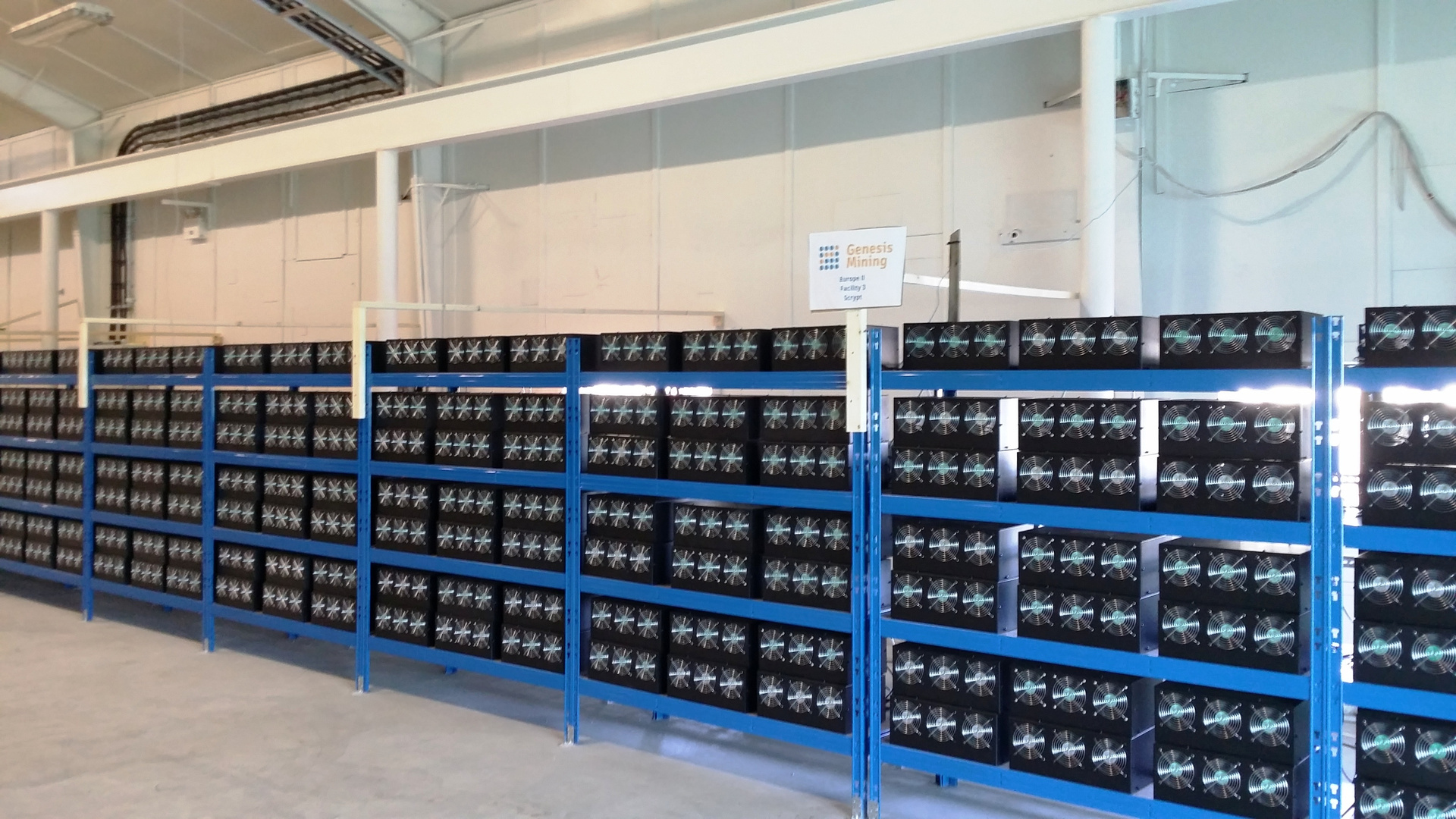
ASIC mining doesn’t look as romantic as modified home PCs, but it's pretty darn efficient (pictured is Genesis Mining Farm, PRC)
The remaining cryptocurrency supporters either re-qualified fast iron for Bitcoin forks and other currencies , with blackjack and without ASIC- cheaters, or they sold video cards and FPGAs to make money on the difference between bitcoins, lightcoins and other currencies.
In 2017 we are obliged by the miners' objection not to Bitcoin (although it also increased in price), but to the newfangled cryptocurrency Zcash and Ether (Ethereum) . The first began to gain popularity as a cryptocurrency for absolute paranoids (fully coded information about transactions), and “Ether” became wildly popular, because it is finally a “proletarian friendly” cryptocurrency. “Ether”, like Bitcoin in the good old days, is the most advantageous thing to mine on video cards. At the same time, the block mining algorithm in Ethereum is protected from the use of ASIC.
On the ground of such joy, mining enthusiasts just for May-June 2017 snapped up new video cards (Radeon RX 470-480 and 500 series analogs, NVIDIA GeForce GTX 1060/1070/1080), joined the pools and provoked a shortage of desktop graphics for a long time to come. By the way, everyone speaks about how valiant Jedi get their currency on Asiki variants and video cards, but few people remember where and how virtual money should be stored so as not to lose all savings in one fell swoop.
An anonymous currency must be an anonymous currency, because it is an anonymous currency! Therefore, cozy web wallets with the mother's maiden name as a “secret” issue and raids of curious special services in cryptocurrencies are not held in high esteem.
But the only correct way to store cryptocurrencies in nature does not exist - miners can choose from:
• Local wallets (Bitcoin / other currency client programs with the wallet.dat file, which stores the access code for money). This type of software can be divided into “full-fledged” options, with a huge blockchain file (monstrous Bitcoin Core, for example), andrepacks with lightweight wallets that load the data you need to work after launch (for example, lightweight Armory). The principle is similar to downloading part of the files from the distribution in BitTorrent. Or, if it is even easier, do you have portable cache or not?
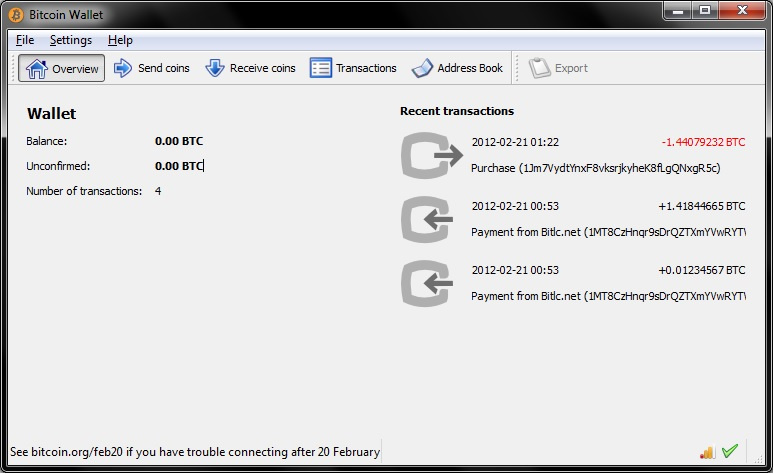
Bitcoin Core, or “offline wallet by default”
• Online services and mobile applications . Kind people who allow you to store the access key to all your Bitcoin in your database with a login and password. On the one hand, you will not have to worry that the PC on which the money is being held will “knock on the outside” and steal data using a new vulnerability. On the other hand, the security of online services rests, literally, “on an honest word,” and if the owners of the service steal money from customers' accounts at once, you will only have to shed tears in thematic forums. They stole the access code to the wallet - it's my own fault. By the way, Apple began to skip Bitcoin wallets in the App Store only in 2014.
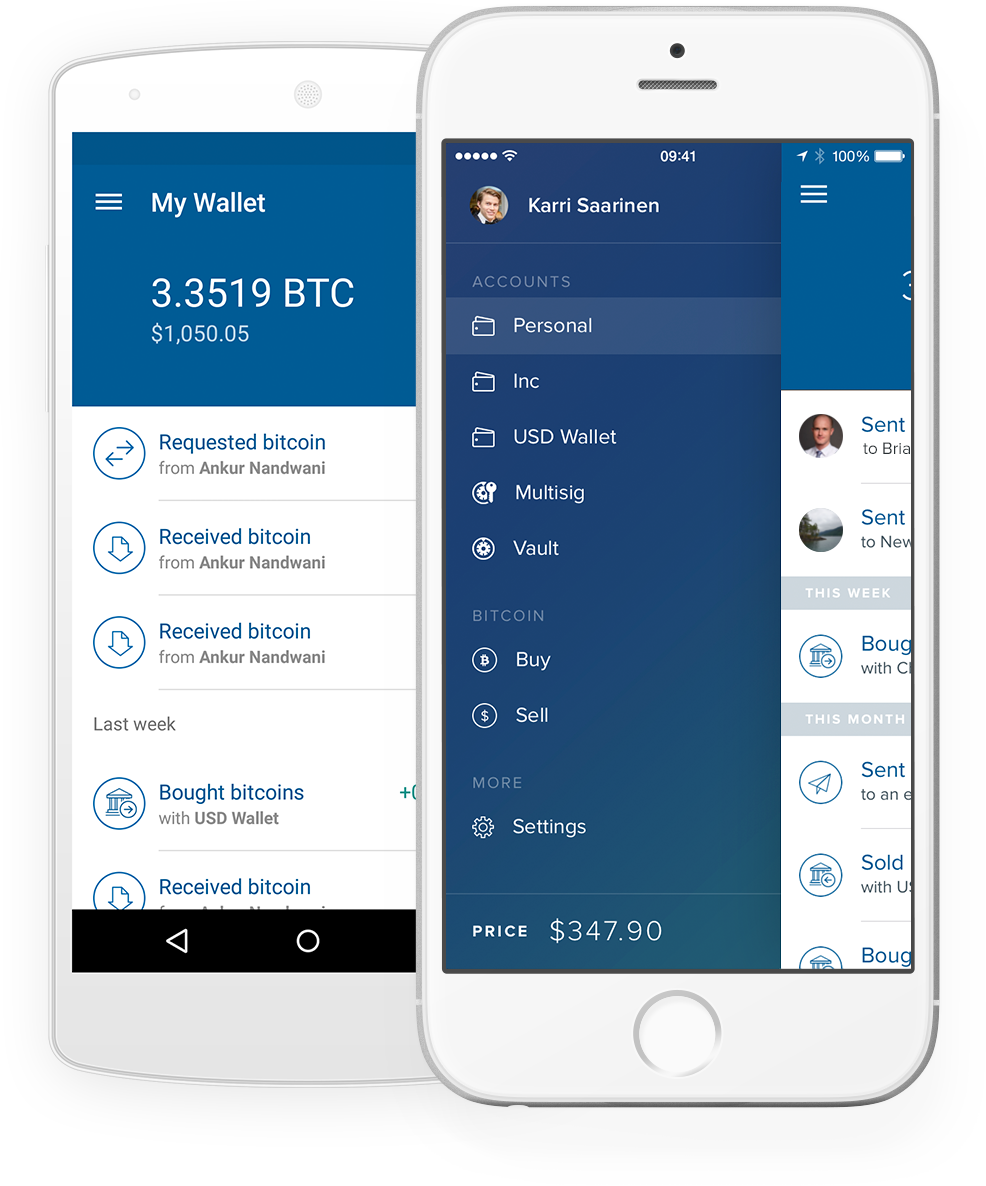
Mobile wallets on smartphones
• Finally, there is ( hardware Bitcoin wallets ) that store currency offline and sign transactions even without being connected to the Internet. However, the most universal option for offline wallet storage can be ... a flash drive with password access and encryption support. And we have them!
The drive, in which the money “hidden by unbearable megahesh money” is stored, certainly should not be a hard disk in a penny Chinese case. And it should hardly be an ordinary flash drive, because:
• Need hardware data access protection . Otherwise, the flash drive will be “brutalized” until blue in the face, and fanatical miners (and those who steal data from them) are patient.
• No third-party drivers . You never know on which computer you need to perform a transaction, it is better to do without unnecessary trouble.
• Any protection from external influence . Not to float away from boats to Hawaii with bitcoins in shorts, but so that coffee spilled on a flash drive does not send it to the forefathers.
In the model lineup of Kingston, such a drive appeared before the new cryptocurrency boom, and its name is Kingston DataTraveler 2000 . Joint development with iStorage - a company that specializes in crack-resistant drives, and ClevX, which develops encryption technology.
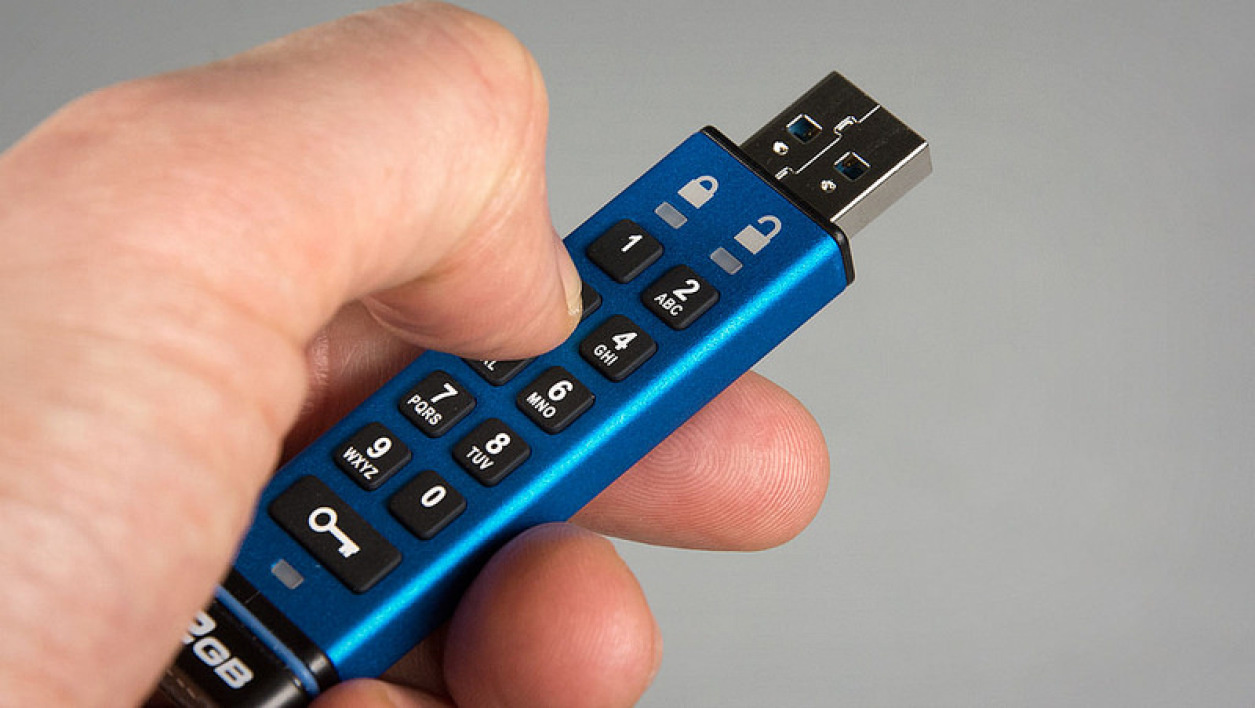
Kingston DataTraveler 2000 - flash drive enhanced personal data protection
So, an aluminum flash drive with pinpad to unlock data access. Press the key with the image of the key and enter the password from 7 to 10 characters long . From this point on, you have 30 seconds to connect the PC's flash drive before the data on it is unlocked again. After you extract DataTraveler 2000 , the data is automatically locked.
If you enter the password 10 times in a row, the flash drive erases the data. In order for the pinpad to live and hello for entering a password, its performance is supported by a Li-Pol battery. The pinpad data reset will occur if the flash drive is on the shelf for a year without a single connection to the PC. When you first connect to the USB battery, of course, charge up. Finally, the flash drive is protected from moisture and dust according to the IP57 standard - it will survive even if it dives briefly to a depth of 1 meter.
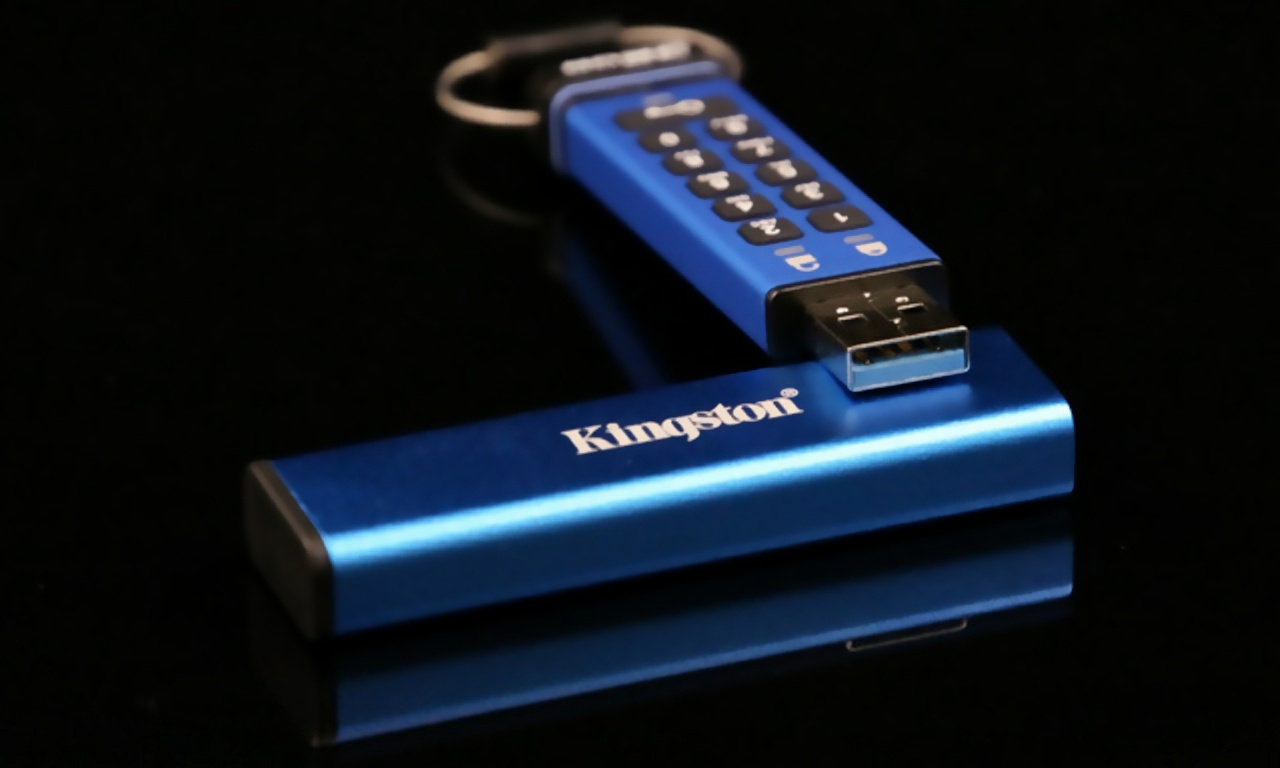
Kingston DataTraveler 2000
The capacity of DataTraveler 2000 extends from 16 to 64 GB, so the drive is more likely intended for “thin” wallets that do not store all Bitcoin blocks in the local storage, but only refer to the necessary blocks. Storage of the entire blockchain will require a drive with at least 128 GB of capacity, but this is a completely different price category. And it is hardly worth hoping that even a protected flash drive will not be hacked if it falls into the hands of special services, but without studying the possible vulnerabilities and targeted attack by an exploit, the attackers will not be able to steal data from such a Kingston drive.
The color design is only one (there is no trendy pink and gold), prices vary depending on the volume and are available for all flash drive options here .
By the way, Kingston also produces a more severe flash drive for organizations -
By the way, Kingston has a more severe flash drive, with 256-bit AES encryption and control using SafeConsole, for organizations. It has both password protection and blocking-formatting after ten unsuccessful access, and many pleasant features of remote administration. Explain for a long time, and it's better to see once - in this video everything is short, but clearly shown.
As soon as the mining of cryptocurrency becomes too time consuming, there are new, more friendly to the masses. Old desktop iron becomes inefficient in mining - enthusiasts are changing to new configurations.

Take care of your Bitcoin wallet from the youth,%% username!
But the salvation of the money of the mayans will always be the work of the miners themselves. Use only proven online exchangers! Check the contents of the ssl certificate (and https support, in principle) before entering confidential data on the sites!Wash your hands before eating! Use sunscreen!
Subscribe and stay with us - it will be interesting!
For more information about Kingston and HyperX products, visit the company's official website . In choosing your kit HyperX help page with visual aids .

Miners: the beginning
They began to talk about “digital gold” 9 years ago - then with caution, not with enthusiasm, like today. Even in Russia, with its relatively inexpensive electric power, few people believed that distributed solving arithmetic problems with subsequent remuneration for, then, “pennies” would become truly profitable. Around the first popular currency of this type, Bitcoin , was puzzled by financial analysts, geeks, entrepreneurs, and traders of prohibited goods. A large number of enthusiasts are still perplexed how “financial pyramids”, which they consider cryptocurrency, can interest someone. Therefore, for those who, for some reason, did not immerse themselves deeply in the subject, we will try to “explain on fingers” the history of the issue.
Since 2008, Bitcoin has remained “elusive Joe” for several years in a row, but banks inconsistently liked transactions independent of banks, and with the advent of exchanges, it finally became possible to “feel” cryptocurrency after cashing. At the same time, the rate showed a steady growth, and organizations and individuals who accepted payment by coin became more day by day. In general, it was not only pizza that could be bought on Bitcoin. And when the currency became popular, and its course set new records, Bitcoin again became a highly specialized topic, “mere mortals” lost all interest in it. Why did it happen?
How to believe in virtual currencies more than real
Bitcoin, as the first cryptocurrency, "shot" not spontaneously, but when the stars came together in the right way:
• Blockchain - all head! Distributed database of all transactions in

The short answer to the question “what did you all find in this bitcoin?”
Vasya’s report “this scoundrel did not pay for work” also spreads throughout the network, so it’s pointless to fake transactions or “cheat” with the results of cryptocurrency mining (solving a mathematical problem with hardware and opening a new Bitcoin block) , and such an operation simply will not be valid.
• There were no legal obstacles to cryptocurrency . They are now outlined, but Bitcoin and the company will not be classified as monetary substitutes, government regulators will not (because this definition is incorrect), and measures to regulate currencies are also very vague.
• Protection against a sudden emission or “we, the US government, have printed more dollars, and then the old ones end.” No one can add to the maximum number of bitcoins (21 million) a little bit more.

Miners around!
True, there are also "pitfalls" - high volatility (fluctuations in the rates of cryptocurrency) and the complexity of mining. The more blocks of cryptocurrency miners opened, the more difficult it was to extract it in the future. In the good old days, Bitcoin could simply be minted on a central processor of a home PC, then it became more profitable to perform mathematical tasks of the same type on a GPU using shader units (ALU - arithmetic and logic unit), and this was a new round of mining.
A peak in the popularity of video card mining came at the release of the Radeon 7000 series and the “six hundredth” NVIDIA GTX in 2012-2013. Architecturally, the “red” video cards of the Southern Islands family (Radeon HD 7700 - 7970) were stuffed with more ALUs than comparable GeForce prices and gaming performance, so the first serious discomfort for gamers was brought to Mass Effect 3 and the first part of Dishonored. There was no real shortage of video cards, but for several months the famous HD 7970 and its younger sisters were much more expensive than competitors from the "green camp".

... and no GTA with a photorealistic mod on this configuration :(
But then the “fever” quickly faded away, because at first the video cards surrendered under the onslaught of more economical, but still universal FPGA computers, and the final mining blow was caused by the ASIC miners , which were computerized for bitcoin mining. Compared to the flagship graphics cards, they were hundreds of times more efficient, so the gaming tools of the public and fans of cryptocurrency gradually ceased to intersect.
Keep it simple, and home PC owners will reach for you
Thus, the extraction of bitcoins from the home entertainment of “amateurs” turned into an occupation for “professionals” who managed to rearm themselves with fast ASIC miners and build farms of them — the people of China distinguished themselves with particular zeal.
An alternative to unprofitable mining at home was renting a cloud for bitcoin mining. Cryptocurrency rates have never been reasonably stable, so the enterprising owners of ASIC chose the “bird in the hand” and instant income from leasing farms, rather than changing earnings prospects on mining.

ASIC mining doesn’t look as romantic as modified home PCs, but it's pretty darn efficient (pictured is Genesis Mining Farm, PRC)
The remaining cryptocurrency supporters either re-qualified fast iron for Bitcoin forks and other currencies , with blackjack and without ASIC- cheaters, or they sold video cards and FPGAs to make money on the difference between bitcoins, lightcoins and other currencies.
In 2017 we are obliged by the miners' objection not to Bitcoin (although it also increased in price), but to the newfangled cryptocurrency Zcash and Ether (Ethereum) . The first began to gain popularity as a cryptocurrency for absolute paranoids (fully coded information about transactions), and “Ether” became wildly popular, because it is finally a “proletarian friendly” cryptocurrency. “Ether”, like Bitcoin in the good old days, is the most advantageous thing to mine on video cards. At the same time, the block mining algorithm in Ethereum is protected from the use of ASIC.
On the ground of such joy, mining enthusiasts just for May-June 2017 snapped up new video cards (Radeon RX 470-480 and 500 series analogs, NVIDIA GeForce GTX 1060/1070/1080), joined the pools and provoked a shortage of desktop graphics for a long time to come. By the way, everyone speaks about how valiant Jedi get their currency on Asiki variants and video cards, but few people remember where and how virtual money should be stored so as not to lose all savings in one fell swoop.
Who should be designated as a virtual money repository?
An anonymous currency must be an anonymous currency, because it is an anonymous currency! Therefore, cozy web wallets with the mother's maiden name as a “secret” issue and raids of curious special services in cryptocurrencies are not held in high esteem.
But the only correct way to store cryptocurrencies in nature does not exist - miners can choose from:
• Local wallets (Bitcoin / other currency client programs with the wallet.dat file, which stores the access code for money). This type of software can be divided into “full-fledged” options, with a huge blockchain file (monstrous Bitcoin Core, for example), and

Bitcoin Core, or “offline wallet by default”
• Online services and mobile applications . Kind people who allow you to store the access key to all your Bitcoin in your database with a login and password. On the one hand, you will not have to worry that the PC on which the money is being held will “knock on the outside” and steal data using a new vulnerability. On the other hand, the security of online services rests, literally, “on an honest word,” and if the owners of the service steal money from customers' accounts at once, you will only have to shed tears in thematic forums. They stole the access code to the wallet - it's my own fault. By the way, Apple began to skip Bitcoin wallets in the App Store only in 2014.

Mobile wallets on smartphones
• Finally, there is ( hardware Bitcoin wallets ) that store currency offline and sign transactions even without being connected to the Internet. However, the most universal option for offline wallet storage can be ... a flash drive with password access and encryption support. And we have them!
Moisture-resistant flash drive-safe for cryptocurrency
The drive, in which the money “hidden by unbearable megahesh money” is stored, certainly should not be a hard disk in a penny Chinese case. And it should hardly be an ordinary flash drive, because:
• Need hardware data access protection . Otherwise, the flash drive will be “brutalized” until blue in the face, and fanatical miners (and those who steal data from them) are patient.
• No third-party drivers . You never know on which computer you need to perform a transaction, it is better to do without unnecessary trouble.
• Any protection from external influence . Not to float away from boats to Hawaii with bitcoins in shorts, but so that coffee spilled on a flash drive does not send it to the forefathers.
In the model lineup of Kingston, such a drive appeared before the new cryptocurrency boom, and its name is Kingston DataTraveler 2000 . Joint development with iStorage - a company that specializes in crack-resistant drives, and ClevX, which develops encryption technology.

Kingston DataTraveler 2000 - flash drive enhanced personal data protection
So, an aluminum flash drive with pinpad to unlock data access. Press the key with the image of the key and enter the password from 7 to 10 characters long . From this point on, you have 30 seconds to connect the PC's flash drive before the data on it is unlocked again. After you extract DataTraveler 2000 , the data is automatically locked.
If you enter the password 10 times in a row, the flash drive erases the data. In order for the pinpad to live and hello for entering a password, its performance is supported by a Li-Pol battery. The pinpad data reset will occur if the flash drive is on the shelf for a year without a single connection to the PC. When you first connect to the USB battery, of course, charge up. Finally, the flash drive is protected from moisture and dust according to the IP57 standard - it will survive even if it dives briefly to a depth of 1 meter.

Kingston DataTraveler 2000
The capacity of DataTraveler 2000 extends from 16 to 64 GB, so the drive is more likely intended for “thin” wallets that do not store all Bitcoin blocks in the local storage, but only refer to the necessary blocks. Storage of the entire blockchain will require a drive with at least 128 GB of capacity, but this is a completely different price category. And it is hardly worth hoping that even a protected flash drive will not be hacked if it falls into the hands of special services, but without studying the possible vulnerabilities and targeted attack by an exploit, the attackers will not be able to steal data from such a Kingston drive.
The color design is only one (there is no trendy pink and gold), prices vary depending on the volume and are available for all flash drive options here .
By the way, Kingston also produces a more severe flash drive for organizations -
By the way, Kingston has a more severe flash drive, with 256-bit AES encryption and control using SafeConsole, for organizations. It has both password protection and blocking-formatting after ten unsuccessful access, and many pleasant features of remote administration. Explain for a long time, and it's better to see once - in this video everything is short, but clearly shown.
The main thing is vigilance!
As soon as the mining of cryptocurrency becomes too time consuming, there are new, more friendly to the masses. Old desktop iron becomes inefficient in mining - enthusiasts are changing to new configurations.

Take care of your Bitcoin wallet from the youth,%% username!
But the salvation of the money of the mayans will always be the work of the miners themselves. Use only proven online exchangers! Check the contents of the ssl certificate (and https support, in principle) before entering confidential data on the sites!
Subscribe and stay with us - it will be interesting!
For more information about Kingston and HyperX products, visit the company's official website . In choosing your kit HyperX help page with visual aids .
All Articles